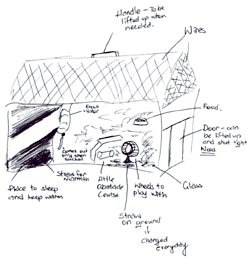Although national monitoring has been designed primarily to present an overall national picture of student achievement, there is some provision for reporting on performance differences among subgroups of the sample. Seven demographic variables are available for creating subgroups, with students divided into two or three subgroups on each variable, as detailed in Chapter 1.
The analyses of the relative performance of subgroups used an overall score for each task, created by adding scores for the most important components of the task.
| Where only two subgroups were compared, differences in task performance between the two subgroups were checked for statistical significance using t-tests. Where three subgroups were compared, one way analysis of variance was used to check for statistically significant differences among the three subgroups. Because the number of students included in each analysis was quite large (approximately 450), the statistical tests were quite sensitive to small differences. To reduce the likelihood of attention being drawn to unimportant differences, the critical level for statistical significance was set at p = .01 (so that differences this large or larger among the subgroups would not be expected by chance in more than one percent of cases). For team tasks, the critical level was raised to p = .05, because of the smaller sample size (120 teams, rather than about 450 students). |  |
For the first four of the seven demographic variables, statistically significant differences among the subgroups were found on less than 10% of tasks of both levels. For the remaining three variables, relating to student gender, student ethnicity and school socio-economic status (decile rating), statistically significant differences were found on more than 10 percent of tasks at both levels. In the report below, all "differences" mentioned are statistically significant differences (to save space, the words "statistically significant" are omitted). |
|
School type
Results were compared for year 8 students attending full primary and intermediate
schools. No differences were found on any of the 25 tasks, or on any question
of the Technology Survey.
 |
School size Results were compared from students in larger, medium sized, and small schools (exact definitions were given in Chapter 1). No differences were found on any of the year 8 tasks or year 4 tasks, but there was a difference on one question of the Year 8 Technology Survey (p45). Students from large schools said they did not like doing technology as much as students from medium and small schools (question 3). |
Community
size |
|
Zone Results achieved by students from Auckland, the rest of the North Island, and the South Island were compared. For year 4 students, there was a difference among the three subgroups on 2 of the 22 tasks. Students from the South Island scored highest on Link Task 6, whereas students from Auckland scored highest on the team task Popcorn Survey. There were no differences on questions of the Technology Survey. For year 8 students, there were differences among the three subgroups on 2 of the 25 tasks. Students from the South Island scored highest on Link Task 1 and Link Task 4. There was also one difference on question 9 of the Technology Survey, with students from South Island schools liking technology more than students in the other two zones (question 3). |
 |
Gender
Results achieved by male and female students were compared. Among year
4 students, boys scored higher than girls on 2 of the 19 tasks that allowed
this comparison: Buzzer
and Link Task 2.
There were no differences on questions of the Technology
Survey. For year 8 students, there were differences between boys and
girls on 7 of the 23 tasks. Boys scored higher on 4 of these tasks: Buzzer,
Link Task 2, Light
the Lights and Link Task
4, with girls scoring higher on the 3 remaining tasks: Taking
Care, Pet House and
Chairs. There were no differences
on questions of the Technology Survey.
Student ethnicity
Results achieved by Mäori and non-Mäori students were compared.
For year 4 students there were differences on 10 of the 19 tasks that allowed this comparison. In all cases, Mäori students scored lower than non-Mäori. The Technology Survey revealed differences on two questions. Compared to non-Mäori students, Mäori students were less positive about how good they were at technology (question 4), but said they used the computer more often when at school (question 7).
For year 8 students, differences were found on 15 of the 23 tasks. Again, Mäori students scored lower on all of these tasks. There was only one difference on the Technology Survey, with non-Mäori students reporting more frequent use of a computer when not at school (question 9).
Socio-economic index Schools are categorised by the Ministry of Education based on census data for the census mesh blocks where children attending the schools live. The SES index takes into account household income levels, categories of employment, and the ethnic mix in the census mesh blocks. The SES index uses ten subdivisions, each containing ten percent of schools (deciles 1 to 10). For our purposes, the bottom three deciles (1-3) formed the low SES group, the middle four deciles (4-7) formed the medium SES group, and the top three deciles (8-10) formed the high SES group. Results were compared for students attending schools in each of these three SES groups. |
|
For year 4 students, there were differences among the three subgroups on 19 of the 22 tasks. In each case, students attending the low SES schools performed worst. While students from high SES schools generally did better than students from medium SES school, these differences were usually smaller than the differences between students from low and medium SES schools. There were no differences on questions of the Technology Survey. For year 8 students, there were differences among the three subgroups on 12 of the 25 tasks. On these 12 tasks, students from high SES schools generally did better than students from medium SES school, who in turn generally did better than students from low SES schools. On the Technology Survey there were differences on two questions relating to computer use (question 7 and 9). Across all three subgroups, computer use was greater when students were not at school, compared to when they were at school. Students from low and high SES schools reported greater use of computers when at school than students from medium SES schools. However, when not at school students from low SES schools said they used a computer less often than students from medium SES schools, who in turn said they used a computer less often than students from high SES schools. |
 |
Summary
School type (full primary or intermediate), school size, community size and geographic zone did not seem to be important factors predicting achievement on the technology tasks. The other three factors revealed more substantial differences. Boys performed better than girls on two tasks (11 percent of tasks) at year 4 level. At year 8 level boys performed better on four tasks (17 percent of tasks), while girls performed better on 3 tasks (13 percent of tasks). Non-Mäori students performed better than Mäori students on ten tasks (53 percent of tasks) at year 4 level and fifteen tasks (65 percent of tasks) at year 8 level. There were statistically significant differences in the performance of students from low, medium and high SES (decile) schools on 86 percent of the year 4 tasks and 48 percent of the year 8 tasks. In the Year 8 Technology Survey all subgroups reported using computers more often when not at school.